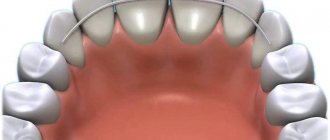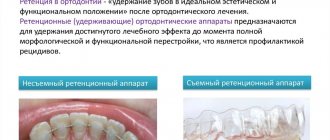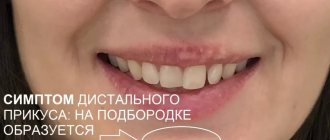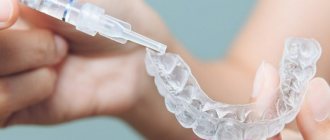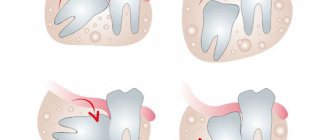This is a headache and a nightmare for any orthodontist: a patient who has had his braces removed and given a removable retainer and instructions for its use returns after some time with complaints about the curvature of his previously straight teeth. The retention period is the most psychologically difficult part of the treatment. Everything is already perfect, and then you have to wear a retainer. Yes, there are other reasons for the unsuccessful outcome of the correction. And although they are much less common, let’s talk about them in more detail.
Correction principle
The method of correcting malocclusion with braces is based on the principle of creating constant pressure on the teeth. Under pressure, the tooth root begins to press on the socket on one side, thereby causing rarefaction of the bone tissue. In the direction of rarefaction, the tooth moves. On the other side of the hole, bone tissue, on the contrary, grows. Thus, after a certain period of time, not only the position of the tooth changes, but also the shape of the socket, which prevents the tooth from returning to its original place.
Correct your bite or dental defect with invisible aligners Find out what it is
Bone tissue grows quite quickly, but it takes quite a long time to “ripen”. That is why, after finishing wearing the brace system, a removable retainer is made for the patient for another year or two or a splint is installed on the incisors and canines. Additional fixation during the retention period helps to avoid repeated tooth curvature.
Gaps between teeth: classification, causes
A variety of reasons can lead to the appearance of three:
- Often we are talking about hereditary predisposition. If at least one parent has trema or diastema, the risk that the child will encounter the same problem is 30%;
- Sometimes the appearance of gaps between teeth is a consequence of bad habits. Among those people who often chew pens and pencils, the percentage of those suffering from gaps between teeth is significantly higher than among those who are free from such habits;
- loss of teeth. The loss of a tooth entails many problems: this is atrophy of bone tissue, this is the process of moving apart the remaining teeth, which entails the appearance of teeth. The displacement of teeth leads to a deformation of the bite, to a change in the entire process of chewing food, and this can negatively affect the functioning of the gastrointestinal tract and human health in general. That is why dentists recommend not to delay and carry out full dental prosthetics.
Depending on which teeth, milk or permanent, we are talking about, trema and diastema are divided into two groups: false and true. Trema are called false if they form between baby teeth, true - respectively, between permanent teeth. A false trema does not always degenerate into a true one, but this is a clear reason for parents to pay attention to the condition of their child’s oral cavity. Make an appointment with an orthodontist and follow his instructions - this will help you minimize the risk of gaps between your permanent teeth.
Possible problems after removing braces
Some people's teeth diverge quickly after completing the correction stage. During the first year, some individuals may only slightly rotate around their axis. Everything is individual, but some general patterns can be identified.
Fanned teeth
A rapid relapse after braces are removed may be due to the following factors:
- Refusal of retainers. Patients often refuse permanent retainers because their installation damages tooth enamel. And it’s annoying to wear removable retainers, even those that are worn only at night. As a result, the teeth return to their previous position, since the new position has not yet been “overgrown” with bone tissue.
- Individual characteristics. There are people in whom new formation and “maturation” of bone tissue proceeds faster than others. And there are those for whom this process is delayed. For some, the displacement of teeth in order to correct the shape of the dentition was insignificant, while for others the tooth “came a long way” before taking its place in the dentition. Teeth quickly “huddle together” after crowding is eliminated. The teeth, which were mixed with braces around their axis, easily turn back.
- Breakage of braces, use of a system of inadequate quality. If the pressure on the teeth during correction was not constant, then the likelihood of an unfavorable outcome increases. You shouldn’t walk around with a broken arch or unstuck locks for a week. It is better to see a doctor on the same day. This will save you from many problems.
- Tooth extraction. When there is not enough space for teeth in the dentition, the orthodontist may decide to remove the “extra” ones. Most often these are fours, eights, less often sixes. The absence of fangs can cause the formation of a diastema. Removing a six causes significant displacement of adjacent teeth.
Loose teeth after braces
Occurs infrequently. In most cases, the feeling of excessive tooth mobility after removing braces is deceptive. It may appear at the very beginning of the retention period and disappear on its own and without treatment. It's another matter if the teeth are really loose. In this case, it is better to seek help from a specialist.
Pain in the teeth and gums
There may be some discomfort after removing braces. Pain occurs especially often after eating solid foods. The reason for this is a change in the condition of the ligaments that hold the roots of the teeth, as well as an increase in the sensitivity of the enamel if the remineralization procedure was not carried out. Reducing the chewing load and using special medications that reduce the sensitivity of teeth and gums help reduce pain.
What determines the stability of treatment?
The preservation of the result in orthodontics is usually called retention. Retentio is a Latin term meaning "preservation", "retention". So, maintaining a beautiful smile does not depend on the money paid by the patient. Even after correction with the coolest expensive ceramic braces or transparent Invisalign aligners, the teeth can move apart very quickly. In some cases, this is due to the fault of the doctor, but much more often the patient himself becomes the source of the problem.
- The teeth will definitely become crooked again if the orthodontist has not identified and eliminated the real cause of the anomaly.
- The doctor is also responsible for the correctness of the treatment program. This means that he must correctly choose the orthodontic design and directions of tooth movement, as well as carefully approach the need to remove those that interfere with effective correction.
- When drawing up a program, a professional will initially focus on a high-quality result, and not on accelerated treatment. With a patient who wants to wear only the “magic” Smartclip self-ligating braces in order to have as few visits to the clinic as possible and correct the bite faster, it is difficult to find a compromise. But without this, it will be impossible to realize his dream of an even, white-toothed smile.
- Finally, to consolidate the result after removing braces, the specialist must offer the patient the optimal retention device. In this case, one should take into account the psychological characteristics of the individual demonstrated during long-term treatment.
This limits the orthodontist's responsibility. If all the rules were followed, and the teeth become crooked again, the patient can only blame himself.
How to remove the gap between the front teeth - methods of treating diastema
There are many ways to eliminate gaps between teeth. The decision to choose a specific treatment method is made by the doctor, based on specific data from the clinical case and the wishes of the patient. The duration of the correction depends on the chosen technique, the age of the person and the severity of the problem. The main ways to close the gap between the front teeth: using braces, crowns or veneers, treatment with orthodontic plates, using mouth guards or aligners, dental restoration. Below are more details about each method:
Bracket systems
- a common method of correcting diastemas. Shifting teeth in the desired direction using a power arc gives a guaranteed and long-term, but not quick result.
Crowns and veneers
- an orthopedic method of correcting a defect, which involves the use of fixed prostheses to close the gap. 2-3 visits to the doctor are enough to get rid of the problem.
Records
- a method of orthodontic correction that is used in childhood. With their help, the teeth move in the right direction and the gap disappears. However, they are practically not used in adult patients.
Aligners or aligners
— removable structures on teeth to correct bite defects, including gaps. More comfortable than braces, but treatment takes longer.
Artistic restoration of teeth
— the method involves concealing the defect using filling material. The result can be obtained in 1 visit to the doctor, but it will not last long enough.
Our dental specialists use only proven and effective treatment methods. Self-medication of diastema and three will not lead to the desired result and can only aggravate the situation.
Classification of diastemas
The phenomenon can be classified according to several fundamental criteria. Treatment is prescribed after the type of disease has been established and the individual characteristics of the patient have been clarified.
At the time of the event:
- False - pathology is characteristic of an early age, when the bite has not yet formed. During the process of changing teeth, it disappears on its own, without outside intervention.
- True - develops after a change of teeth and the formation of a bite, as well as in adults due to injuries, periodontal pathologies or premature prosthetics.
Important. In adults, a crack that appears will not disappear on its own. To correct the defect, you need to visit a doctor.
By location:
- symmetrical - the incisors are located symmetrically relative to each other and to the conventional center of the dentition;
- asymmetrical - one of the incisors deviates to the side, the second takes a natural position.
According to the position of teeth and roots:
- Lateral deviation of the crown. Assumes lateral deflection of the incisors with correct root position. This usually happens with extra teeth. The diastema is usually small.
- Lateral body movement. This is a lateral displacement of the tooth along with the root. One reason is hardened bone tissue along the central suture, which prevents teeth from erupting in the right place.
- Medial inclination of central incisal crowns is the most difficult case. Both teeth and roots shift. In this case, the crowns can expand to the sides or move around their own axis.
Preventive actions
To prevent teeth from moving apart in the future after removing braces, you must strictly follow the advice and recommendations of specialists. For the first six months, the system should be worn 24 hours a day, and only in the next six months can braces be worn only at night. After a year and a half, braces are installed every other night.
The doctor should monitor the correction of the bite at least twice a month. To prevent relapse, it is still recommended to install retainers after removing braces.
Do I need to get rid of diastema?
The issue is controversial, as is the harm from the anomaly itself. It all depends on the cause of the problem, the distance between the teeth and the quality of other dental units. For example, a 4-5 mm diastema not only spoils the appearance of a smile, but also causes neighboring teeth to move. As a result, malocclusion occurs and the antagonists of the lower jaw suffer. Often, a chip has a negative impact on the quality of diction and the health of the gums. A gap of 1-2 mm in size may be safe for the condition of the oral cavity, but cause psychological discomfort. And this is a sufficient reason to eliminate the anomaly.
It is worth remembering that a lot depends on age. If we are talking about a 10-year-old child, then the diastema may be false. That is, in the process of formation of the bite, growth and movement of the teeth, the situation will improve. But you shouldn’t rely on this without a dentist’s opinion.
Symptoms
In some situations, loosening of elements is considered a sign of pathology. There are clinical situations when patients develop inflammation in the hard tissues or oral mucosa during treatment.
It is recommended to seek dental care if the following warning signs appear:
- Redness, swelling and bleeding of mucous tissue.
- Molar caries.
- Erosions and ulcers on the gums and inner surface of the cheeks.
- Increased abrasion of enamel.
- Pain in certain areas of the jaw.
- Discharge of pus.
These symptoms indicate the development of serious dental diseases that require urgent treatment. In the absence of proper treatment, there is a risk of destruction or loss of units, the occurrence of purulent-inflammatory processes and other complications.
The causes of loose teeth are lack of regular oral hygiene, jaw injuries and non-compliance with medical recommendations.
The basic principle of dental correction
Many people know that in the dental system, as well as in other systems of the body, nothing happens for nothing. Various anomalies and pathologies also have their own causes and symptoms. It is for this reason that in order to achieve a good effect when correcting a bite, these points should be taken into account and all efforts should be directed towards correcting it.
The installation of a braces system is aimed at returning teeth that have left their “rightful” places to their natural position without surgical intervention and complex deformations. When installing braces, it is necessary to adjust the position of the elastic bands so that the design completely corrects the patient’s bite.
After all the elastic bands have been tensioned correctly, everything should then be entrusted to the ligaments located in the celibular part of the skull. They are particularly elastic and can change their position, albeit very slowly. To prevent teeth and ligaments from returning to their previous position, retainers should be installed. These designs allow you to consolidate the achieved result.
